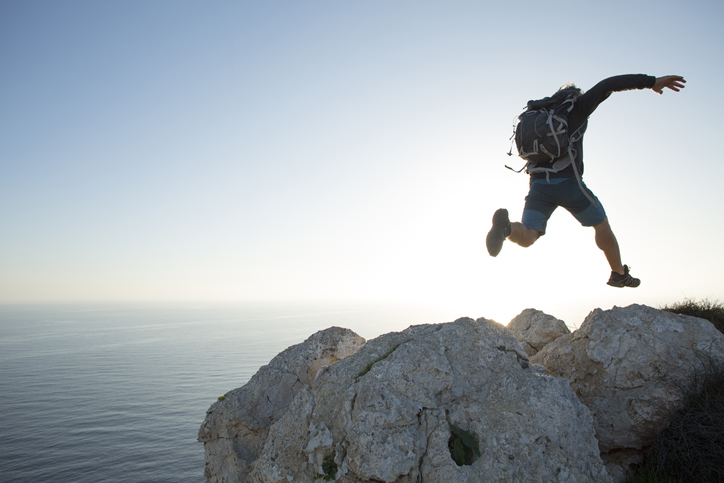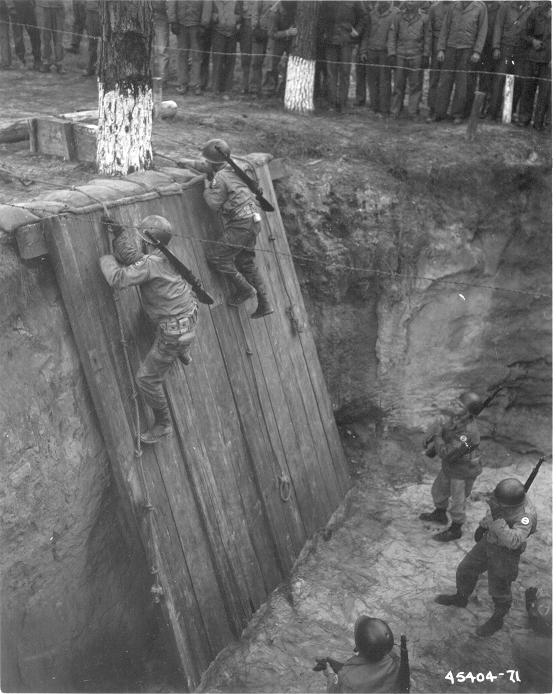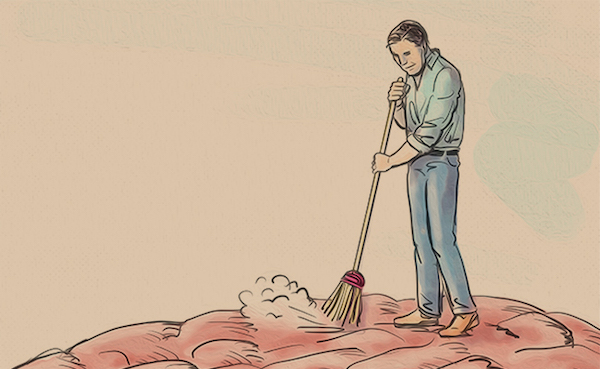
In the United States, over sixty percent of people live a sedentary lifestyle. A quarter of the population gets no physical activity at all.
Maybe you’re one of these sedentary folks. Physical activity is just not something you do. It’s not part of your life.
Why is this? Why are so many adults physically inactive?
It likely goes back to their childhood, and the fact that they never developed a physical identity.
The Athlete/Non-Athlete Tracks of Childhood and How Kids Lose Their Physical Identity
Dr. Daniel O’Neill, author of Survival of the Fit, defines “physical identity” as the innate human drive we’re all born with to move our bodies through space. Take a look at toddlers. They love to move. They roll, crawl, climb, and run around like maniacs. They’ll pick up stuff and throw it for no reason at all. They take a playful approach to life.
But according to Dr. O’Neill, kids lose their physical identity if that playful, active approach to the world isn’t fostered and encouraged as they move beyond the toddler years.
The loss of a physical identity often happens because of the two tracks which tend to form during modern childhood.
Children on the first track show an innate athleticism and/or interest in sports from a young age. Their parents sign them up for sports — T-ball, basketball, soccer, football, tennis — and the kids take a liking to these sports and stick with them. They go out for the team when they get into high school. They go to camps to improve their skills and do strength and conditioning courses during the off-season.
These kids not only develop a physical identity but also what O’Neill calls an “athlete identity.” You generally don’t have to worry about them when it comes to being and staying physically active. Though they sometimes pass through a sedentary season of life after high school, in which they have to learn to be physically active outside the realm of organized sports, they tend to eventually rediscover physical activity as a personal pursuit and remain active through adulthood.
Kids on the second track, and these may constitute up to two-thirds of children, don’t demonstrate innate athleticism or interest in sports when they’re young. Their parents decide that sports aren’t for them. Or their parents do sign them up for sports, but they don’t take to it and don’t end up wanting to continue.
Because so much of physical activity in modern childhood centers around sports, kids who opt out of them often don’t get much physical activity of any kind. In another time, children who didn’t do organized sports might still get in some activity by riding bikes, building forts, and playing impromptu games of wallball and manhunt with neighborhood friends. But the rise of smaller families (making for less kid-population-dense neighborhoods) and the advent of screens have made this kind of free play less common. In another time too, kids who didn’t do organized sports would still get experience with physical exercise through participation in their school’s P.E. program. But P.E. programs have been dialed back in schools across the country and are often non-existent in high school.
Thus, for kids who don’t do sports, physical activity can practically drop out of their lives altogether. Instead of participating in athletics, kids on this second track may default to doing more screen time and playing video games. Or they may get into more constructive interests like music, art, and theater.
Because children on this second track don’t develop an “athlete identity,” they don’t develop a physical identity, either. In fact, because they associate having a physical identity with sports, and they’re not into sports, they may partly come to define themselves in opposition to that physical identity; “I’m not like the dumb jocks.”
Kids on the second track may have healthy interests, but their physical health isn’t as optimal as it could be, and the consequences of that catch up with them when they transition from being sedentary children to joining the two-thirds of the world’s population who live as sedentary adults.
Because of the way an overemphasis on organized sports during childhood leads to an all-or-nothing conflation between sports and physical activity, Dr. O’Neill argues that sports ironically represent one of the biggest obstacles to the widespread formation of a physical identity in children. A false dichotomy is created where if you’re not into sports, you’re not into physical activity, period. But just because you’re not an “athlete,” doesn’t mean you aren’t a physical being.
What You Miss Out On When You Don’t Have a Physical Identity
In Survival of the Fit, Dr. O’Neill spends a lot of time detailing the health issues that come with not having a physical identity. When you lack a physical identity, you tend to be physically inactive. Because you move less, you increase your risk of all the physical and mental health issues a sedentary lifestyle creates: obesity, cardiovascular disease, muscle atrophy, insulin resistance, depression, and anxiety.
But O’Neill also points out that when you lack a physical identity, you increase the chance of missing out on many of the world’s joys and pleasures.
If you don’t foster the physical side of yourself as a kid because you associate physicality with sports and you aren’t into sports, you consequently don’t develop the physical awareness and aptitude — the physical comfort and confidence — to participate in the vast array of active, non-sport pursuits that can be kindled in youth and become enduring pastimes in adulthood. Hiking, climbing, dancing, hunting, skating, swimming, cycling, kayaking, and skiing are all physical activities that can greatly enrich your life and which you can do without ever having to think of yourself as an athlete.
When you don’t have a physical identity, you can miss out on the joys of exploring a beautiful waterfall with your family, running through the woods with friends, feeling the cold wind rush against your face as you snowboard down a mountain.
We are embodied beings. When you cut yourself off from physical activity, you cut yourself off from many of the most animating layers of human existence.
How to Nurture Your Kids’ Physical Identity
If you want to ensure your kids have a physical identity as adults, and a good shot at lifelong health and joy, you need to nurture their physical identity while they’re young. The goal is to help your kids keep and grow the physical identity they were born with.
O’Neill believes that one of the best ways to help our kids do this is to expand and reinvigorate P.E in our children’s schools and make it the absolute core of their entire education. He rightly argues that physical activity is the solution to almost all the problems that face our youth specifically and our population broadly, and that a foundation of physical health facilitates all other forms of learning. A sound mind in a sound body!
O’Neill thinks P.E. should be mandatory from kindergarten through twelfth grade, and its emphasis should be on varied forms of vigorous physical activity — instead of just sports. He’s not against sports, mind you. He just doesn’t want sports to be done to the exclusion of all other kinds of exercise.
O’Neill exhorts people to advocate for better P.E programs in their children’s schools, and this is a cause that parents should look into; what’s the quality of the physical education your children are receiving? Can anything be done to improve it?
While making change in this area is of course difficult, there are fortunately other things parents can do at home to foster a physical identity in their kids:
Be physically active yourself. Kids model what they see. What pattern are you setting in your home? If your kids see that you and your wife are physically active, they’re more likely to be physically active themselves. Exemplify what a physical identity looks like to your children.
Make physical activity a regular, normal part of your family’s life together. Incorporate physical activity into your family’s culture. Roughhouse with your kids. Take family walks and bike rides. Go on hikes. Play pick-up basketball in the driveway. Skank to Five Iron Frenzy. Go canoeing. Have cartwheel competitions. Play tag. Go skiing. Climb mountains.
Introduce your kids to as many physical pastimes as possible; you never know which activities will become lifelong loves for them.
Still consider sports. Sports are inadequate for addressing our society-wide lack of physical activity as they represent a net that will ultimately only encompass a minority of kids. But we’d still argue that sports remain one of the best entryways for developing a physical identity, a lifelong interest in physical activity, and other aspects of good character too. Instead of dismissing sports, we should look for ways to get more kids involved in them.
For one thing, don’t write off kids as being non-athletic too soon. While plenty of aspects of a child’s personality manifest themselves right from the time they exit the womb, sometimes it can be hard to tell whether a kid will take to sports or not, and you don’t want to turn a premature assessment into a self-fulfilling prophecy: you don’t think they’re made for sports, so you don’t put them in sports, and they thus don’t develop any athletic ability, which confirms that sports weren’t for them. We’ve seen cases where little kids were seemingly pretty nerdy and physically awkward, but nonetheless got involved with sports, took surprisingly well to them, and activated a side of themselves that otherwise would have gone undeveloped.
Little kids are up for trying whatever, so give them experience with different sports and see what happens. Maybe they won’t like it and will want to opt out. But maybe they’ll find something they really dig.
And when you enroll kids in sports, start them off with lower-key, less competitive leagues. Sometimes a kid thinks he doesn’t like sports, but what he actually doesn’t like is the too-pressurized atmosphere in which he first tried them. Sports for kids should be fun, a positive experience that makes them want to keep with it — if not with that specific sport, then with physical activity in general.
The key with sports is that they should be a supplement to developing a child’s overall physical identity, and not the sole component. That way, should the kid decide that sports aren’t for him, he’s still got other outlets in his life that’ll keep him in contact with a current of physicality.
How to Nurture Your Own Physical Identity
Maybe you’re reading this and recognize yourself as someone who came of age on the second track of childhood. You don’t regret the other interests you pursued in lieu of sports, but do lament the fact you didn’t develop a physical identity too. Well, it’s not too late for you to nurture one. Remember: you were born with a physical identity — it may just be dormant from lack of use.
Disassociate physical activity from sports. The first key for adults who want to develop a physical identity is to disassociate physical activity from sports. There are still middle-aged folks out there who don’t feel like physical activity is for them because they weren’t athletes in high school and still kind of define themselves as not being like the stereotypical jocks they knew back in the day.
Throw out the old binaries you may still carry around from your teen years. You can be bookish, musical, and/or artistic and physically active.
Hiking, frisbee, parkour, dancing, yoga, skiing, swimming, geocaching. There’s a world of physical activity out there beyond sports.
Pick something you enjoy. One of the biggest takeaways from all the podcast interviews we’ve done over the years comes from behavioral scientist Michelle Segar. Her research has shown that you’re more likely to stick to regular physical activity if you enjoy it. Duh!
But many adults approach physical activity the way kids approach taking Robitussin: by stifling a gag and pinching their noses.
Don’t approach physical activity like you’re taking a spoonful of medicine. Don’t do the physical activity you think you should do. Do the kind of physical activity you actually enjoy.
If that’s walking, great! Do that. If it’s MovNat, go for it! Like to lift weights? Get under the bar. Experiment. Sign up for tennis lessons. Spend a week swimming at a community pool. Find the thing that joyfully lights up your physical identity and makes you look forward to getting in touch with your embodied self each day.
For more on the importance of having a physical identity, listen to our podcast with Dr. Daniel O’Neill:







